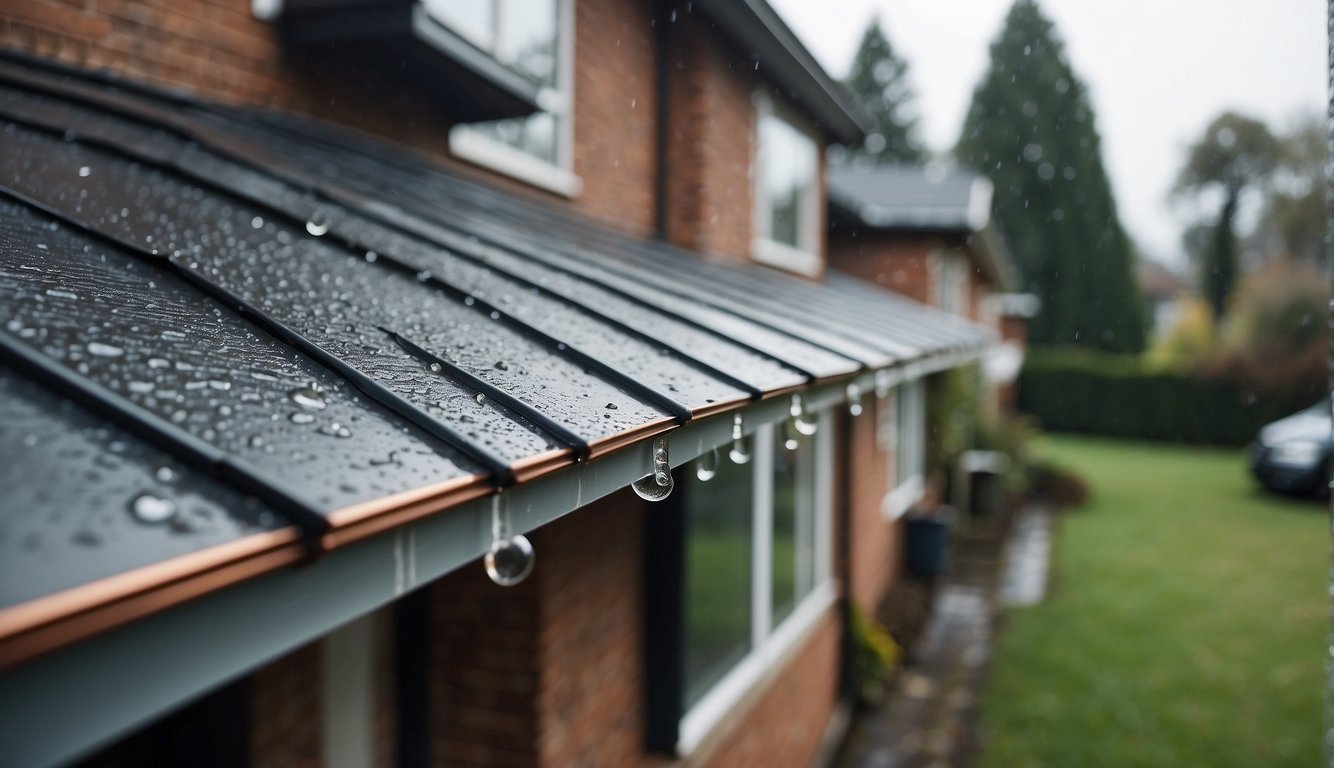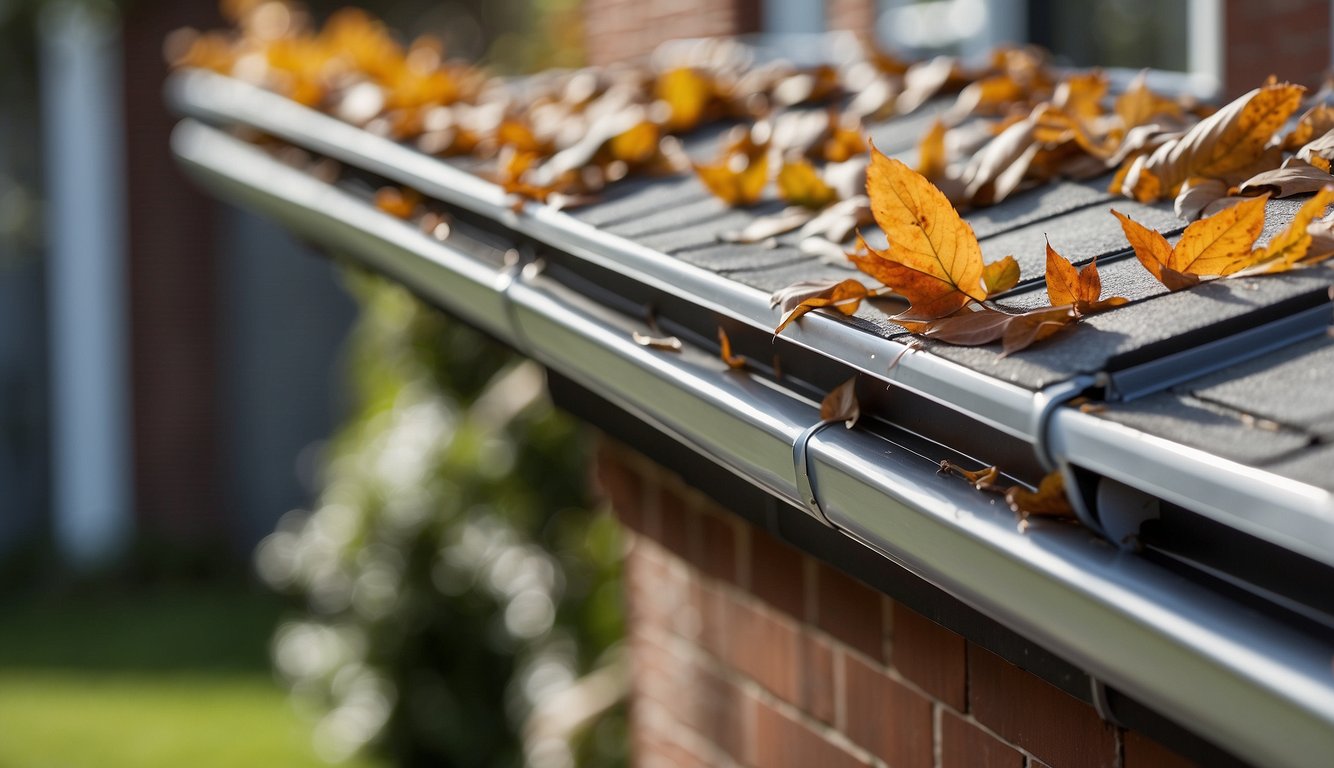What is the Best Material for Gutters: Durability and Efficiency Compared
Choosing the right gutter material is essential for ensuring the longevity and effectiveness of your gutter system. We know gutters protect your home from water damage by channeling rainwater away from your foundation and landscaping. Materials commonly used for gutters include aluminum, copper, steel, zinc, and vinyl, each with unique advantages and considerations.

Aluminum gutters are favored for their combination of durability and cost-effectiveness. They are lightweight, rustproof, and come in a range of colors, making them a versatile choice for many homes. Copper gutters are another option and are highly durable with a lifespan of 50 years or more. They do not rust and can add an aesthetic appeal to a property, but they come at a higher cost.
When selecting gutter materials, consider factors such as the climate, the style of your home, and maintenance requirements. We understand that gutters don’t just need to be functional; they should blend with your home’s exterior and require minimal upkeep. Whether you opt for the affordable and popular aluminum or the upscale and long-lasting copper, the best gutters for your home depend on balancing cost, durability, appearance, and ease of maintenance.
Choosing the Right Gutter Material
When selecting gutters, the material is crucial, impacting durability, maintenance, and cost. Let’s assess common materials to guide your choice.
Aluminum Gutters: Pros and Cons
Pros:
- Rust-resistant: Aluminum won’t rust, adding to its longevity.
- Lightweight: Easy to handle and install, cutting down labor costs.
Cons:
- Prone to dents from ladders and debris due to its malleability.
- Color may fade over time, requiring repainting.
Steel and Galvanized Steel Gutters: Pros and Cons
Pros:
- Durable: Both variants withstand severe weather.
- Steel: Substantial material, less likely to dent compared to aluminum.
Cons:
- Rust potential: Steel can rust; galvanized needs periodic inspection.
- Heavier, requiring professional installation.
Vinyl Gutters: Pros and Cons
Pros:
- Maintenance-free: Vinyl is resistant to rust and rot.
- Cost-effective: Less expensive than metal options and easy to install.
Cons:
- Brittle in extreme cold, may crack.
- Less lifespan than metal gutters, typically 10-20 years.
Copper and Zinc Gutters: Pros and Cons
Pros:
- Attractive: Offers an elegant aesthetic that can enhance siding design.
- Longevity: Copper and zinc are extremely durable, lasting decades.
Cons:
- More expensive: These materials are a greater upfront investment.
- Pre-weathered Zinc Gutters: Gradual patina changes appearance over time.
Gutter Designs and Types
Selecting the right gutter design is critical for both the function and the aesthetic appeal of your home. Our focus here is on the primary styles which include K-Style, Half-Round, and Fascia or Box-Style gutters, each with their distinct features and benefits.
K-Style Gutters
K-Style gutters are preferred for their versatility and ease of installation. Resembling the letter ‘K’ from the side, their flat back design allows them to be directly attached to the fascia board. Durability is a key benefit, with these gutters capable of handling more water than other styles, making them suitable for areas with heavy rainfall.
- Main Features:
- Design: Resembles decorative crown molding
- Mount: Attaches directly to fascia board
- Capacity: High water volume
Half-Round Gutters
Half-Round gutters are known for their smooth, semicircular design which is ideal for homes with a more traditional or historical appearance. They typically feature round downspouts and are available in 5-inch and 6-inch widths. While they don’t carry as much water as K-Style gutters, their shape allows for easier cleaning and reduced debris accumulation.
- Main Features:
- Design: Smooth, rounded trough
- Mount: Works with various hanger styles
- Capacity: Efficient but less than K-Style
Fascia and Box-Style Gutters
Fascia gutters, often custom-designed, are integrated with the fascia board, creating a seamless look. Box-style gutters are larger and more visible, often used on commercial or very large residential buildings. Both types can be tailored to match the home’s architecture, offering a more integrated aesthetic.
- Main Features:
- Design: Tailored to blend with fascia board or visibly distinct as with box-style
- Mount: Custom fit or heavy-duty support for box-style
- Capacity: Customizable based on needs and design requirements
Installation and Maintenance by Material for Gutters
Choosing the right gutters for your home involves considering how they will be installed and maintained. Proper installation ensures that gutter systems effectively manage drainage, while regular maintenance is crucial for long-term performance and avoiding costly repairs.
Professional vs. DIY Installation
Professional Installation offers the benefit of experienced gutter installers using the right tools and techniques. This route typically results in:
- Quicker and safer installation: Experts are equipped to handle various heights and building layouts.
- Warranty protection: Many professional installations come with service guarantees.
DIY Installation can save money and may be sufficient for handy homeowners who are:
- Comfortable with heights and have the required tools.
- Installing sectional gutters which come in manageable lengths and are simpler to piece together than seamless gutters.
| Installation Type | Cost Efficiency | Time Investment | Skill Level Required | Quality Assurance |
|---|---|---|---|---|
| Professional Installation | Lower | Minimal | N/A | Higher |
| DIY Installation | Higher | Extensive | Intermediate | Variable |
Maintenance Considerations
Regular maintenance of gutter systems is necessary to prevent blockages and damage. Cleaning should be done biannually to remove any debris.
- Gutter Guards: Investing in guards like LeafFilter can decrease the amount of debris accumulation.
- Regular Inspections: Checking for rust, and ensuring hangers are secure, can help prevent the need for more significant repairs later.
Repair varies based on material and condition:
- Vinyl and aluminum gutters might require sealant or replacement sections.
- Copper and steel gutters typically last longer but may require professional attention when issues arise.
Maintaining downspouts is equally important as they are critical to guiding water away from the foundation. A blocked or faulty downspout can compromise the entire gutter system.
Gutter Protection and Enhancement
To safeguard your home’s rain gutter systems, investing in high-quality gutter guards is crucial. These enhancements can dramatically reduce maintenance while ensuring optimal performance.
The Role of Gutter Guards
Gutter guards serve as a barrier, preventing leaves, debris, and other obstructions from clogging your gutters. The design of a gutter guard is pivotal to its effectiveness. A well-chosen gutter guard can maintain water flow, reduce the buildup of debris, and significantly cut down on gutter maintenance.
- Quality: High-quality gutter guards keep gutters clean and free-flowing.
- Performance: Effective designs like micro-mesh or reverse curves improve water drainage and prevent clogging.
Enhancing Gutter Functionality
To get the most out of your rain gutter systems beyond gutter guards, consider the following enhancements:
- Downspouts: Make sure they are clear and in good repair.
- Splash Blocks: These direct water away from the foundation and help prevent soil erosion.
- Maintenance: Regular checks, especially after heavy weather conditions, ensure the durability of the system.
By focusing on these areas, our gutter system remains highly functional, ensuring proper drainage around the home.
Factors Affecting Gutter Performance and Longevity

A gutter’s performance and longevity are influenced by its material quality, proper installation, and the environmental conditions it faces. We’ll explore how these factors can lead to damage or wear and the need for replacement.
Importance of Proper Installation
Proper gutter installation is pivotal for optimal performance. Incorrectly installed gutters can lead to a multitude of problems:
- Sagging: Can occur if the gutter hangers are spaced too far apart.
- Water Damage: Poorly secured gutters can pull away from the fascia board, leading to water infiltration.
- Seams: Gutter systems with more seams may be prone to leaks, which is why seamless gutters are often a superior choice.
A professional installation ensures the correct pitch and secure attachment, vital for efficient water runoff and minimizing long-term wear.
Weather and Environmental Impact
Weather and environmental factors can greatly impact gutter durability:
- Weather Damage: Extreme conditions, like heavy snowfall or high winds, can damage gutters.
- Trees: Nearby trees may increase the risk of damage from fallen branches or leaves clogging the gutters.
- Rusting: Metal gutters, especially steel, can rust over time, though aluminum and copper resist this process.
- Mold and Mildew: Consistent moisture and debris buildup can lead to mold and mildew, which compromise gutter material integrity.
Regular maintenance helps mitigate these effects and prolongs the gutter system’s life.
Let Us Know How We’re Doing!
Did this expertly prepared resource answer your question?
Do you have another question about home maintenance, home improvement projects, home appliance repair, or something else?
Get more information, send in questions and keep the discussion going by contacting the I’ll Just Fix It Myself company customer service team at at 1-800-928-1490 or Email us at [email protected]
